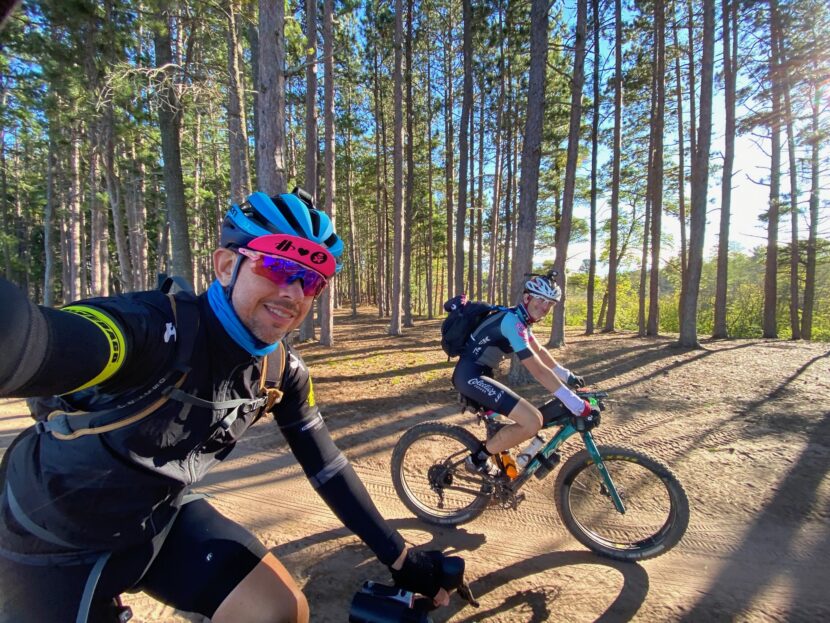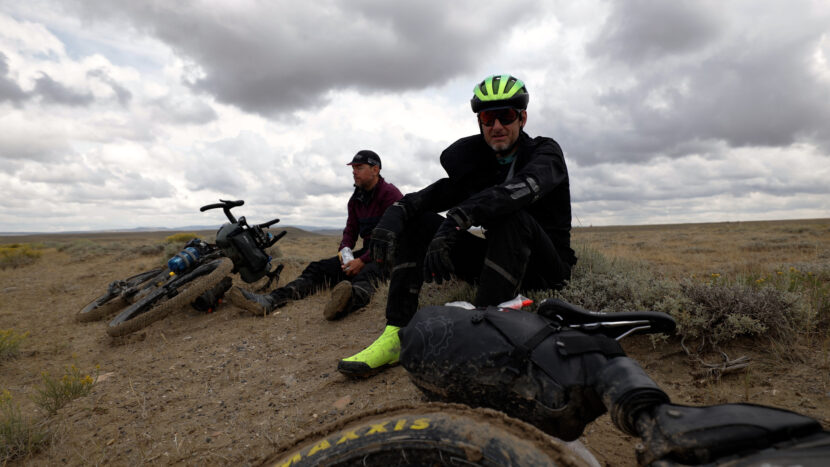
Tracing the Divide
Tracing the Divide is a breathtaking documentary featuring two Wisconsin life-long best friends and cyclists, Christopher Schmidt and Chris Hiebert. The film, produced by young filmmaker Jack Zakrajsek and Lunar Door, beautifully depicts a 24-day cycling adventure down the continental divide and is a memorable exploration of friendship and adventure.
The lengthy ride all started with an idea by Christopher Schmidt, an avid cyclist and anesthesiologist from Lake Geneva who had years of experience in the mountain biking and cyclocross world explains that in late 2019 he was looking for something new. “I wanted a challenge that would push my limits, and a friend showed me the Adventure Cycling Association’s Great Divide Mountain Bike Route (GDMBR), a route that runs from Canada to Mexico. I knew I had to do it.”
The Ride
The 3100-mile GDMBR is internationally renowned. Connecting Jasper, AB to Antelope Wells, NM it generally follows the Continental Divide through the Rocky Mountains. It boasts over 200,000 feet of elevation gain along with an array of climate and geographical differences.
Enthralled with the idea of tackling this, Schmidt contacted his lifelong best friend and fellow cyclist, Chris Hiebert, an engineer from Menomonee Falls and told him about the route and asked him to join. Awed by the concept, Hiebert was a bit reluctant. Reflecting back, Hiebert notes, “I thought that maybe someday we could do the whole thing, but then I couldn’t get that route out of my head.”
Determined to have Hiebert on board, Schmidt persisted and after dozens of conversations with Hiebert and the support of their families, they both committed. The only issue – neither of them had even done an overnight bikepacking adventure. It was a new arena of cycling, and they needed experience.
“We knew we had to do test events,” says Schmidt. “We figured if we didn’t like small scale bikepacking adventures, then we wouldn’t like the Divide.”

Preparation
They dipped their toes into the waters of bikepacking by signing up for their first serious bikepacking race, the 2020 Heck Epic (now called ‘The Wolf’), a three-day, 320-mile, ultra race in Minnesota. From gravel roads and doubletrack to a derecho storm and a sleepless night, it was a brutal test run, but they enjoyed it. It provided a foundational experience with consecutive off-road days of 100 plus mile rides.
“That race was no joke,” states Hiebert. “It was so rugged. All that vibration. I could barely hold a fork for weeks afterward.”
“The issue was also Hiebert’s manual shifting,” Schmidt explains. “Racing on rough terrain requires frequent gear changes.” Because of this, Hiebert upgraded to electronic shifting and went for a bike fit to make the necessary adjustments to prevent future injuries. Small tweaks like this were imperative for success, especially on the GDMBR.
After completing the Heck Epic, they signed up for the punishing Crusher 225EX, a 260-mile race traversing the rough terrain of upper Michigan with a goal of finishing under the 30-hour cutoff to get their “green dot” and the coveted Crusher finisher’s mug. Mugs that they later brought on the Divide. They successfully finished in 29 hours, but this adventure was not without mishaps and hilarious situations.
They laugh as they recount how they approached the Yellow Dog River in the middle of the frigid night. From their online research, riders had warned that the water could be deep and dangerous. Knowing they had to cross with all their gear, hypothermia was a concern. To keep warm, Schmidt suggested they strip down and hoist their bikes above their heads.
Hiebert grins and shakes his head as he recalls that night. “I told him, ‘I bet this water is no deeper than our ankles.’” Naked and freezing, they hoisted their bikes over their heads as they crossed. “Sure enough, the water wasn’t more than shin deep,” Schmidt laughs ruefully and shrugs.
With the first two test races under their belts, they were getting accustomed to training and competing with loaded bikes, but they knew that they had to expose themselves to harsher conditions. In January 2021, in cold snowy weather, they loaded their bikes and rode from New Glarus to Blue Mound State Park to take on Jay Petervary’s Fat Pursuit challenge (COVID Edition). They dug through the snow at the end of the day to find a spot to camp, melted some snow to make dinner, hunkered down for the night, and then in the morning finished their ride.
These successful adventures boosted their confidence, and they continued training and began researching the GDMBR in earnest, scouring the internet for information. They watched countless Divide cycling videos on YouTube, read books, took detailed notes, and educated themselves on all the motivational and tactical aspects. With the Canadian border closed due to COVID, they focused on compiling information about water and food stops, camp sites, and hotels along the 2400-mile portion in the US; and prepared themselves for wildlife encounters, particularly bear encounters.
Physical and practical preparation wasn’t the only consideration – the mental aspect of the ride was of concern, especially to Hiebert. He read an article that advised those attempting the route to “make sure you have no loose ends before you leave, they can make or break you.”
“That really stuck with me,” Hiebert admits. “You have so much time to think on a bike.” Hiebert considered the challenging emotional and mental aspects of the ride as he continued his preparation.

Movie Making
As the summer of 2021 unfolded, Schmidt had an idea about documenting the adventure. He reached out to 20-year-old Jack Zakrajsek, a cyclist and aspiring filmmaker, and close family friend.
“I invited Jack to follow and document the adventure. I thought it could be a cool opportunity for him. He could camp along the way in his truck and when opportunities presented themselves, he could film us and use his drone. I was thinking maybe we could have some fun videos to show our family and friends after the trip, at the time we had no idea it would turn into a feature film. That was an unexpected bonus.”
At first Zakrajsek declined Schmidt’s invite but then quickly changed his mind. Intrigued by the idea of gaining more experience with film and photography, he agreed to follow and be a part of their adventure, documenting but not supporting in any way.
Bikes cleaned and dialed, gear packed perfectly, Schmidt and Hiebert flew to Montana and excitedly began their adventure on the morning of August 8, 2021, with Zakrajsek trailing closely in his vehicle, camera and drone at the ready. He was constantly filming, photographing, and catching raw moments between Hiebert and Schmidt.
Schmidt and Hiebert quickly forgot about the filming as their attention had to be on the ride. The rigors of the route required diligence when it came to self-care. Knowing saddle sores could be an issue they cleaned with wipes every day and used zinc oxide as prevention. But still, all those miles took their toll, and fatigue and injury set in quickly – the physical demands of the GDMBR humbled Schmidt and Hiebert.
“It wasn’t easy,” Schmidt recalls, reflecting on the first days of the ride. “Knee pain was a huge issue for me. At one point it felt like I was kneeling on broken glass with every pedal stroke. It made me question if I could even finish.”
Thankfully, Schmidt had a remedy for the knee pain; he realized he had set the saddle a bit lower than normal and after adjusting things the pain diminished. With one problem solved, more arose. Each day presented a new set of challenges and mishaps.

On a particularly rough section of gravel road crossing into Wyoming, Hiebert began to cough whenever he was behind Schmidt. He thought it was strange, and both thought that maybe it was the wildfires that were in the area causing lung irritation, but this didn’t add up. Then the wind changed directions, and Schmidt began hacking as he noticed a mist coming from the bear spray that was mounted on his handlebars.
“That stupid gravel section, the constant pounding, actually wore a hole in the can,” Schmidt grimaces, shaking his head. The noxious chemicals from the bear spray contaminated Schmidt and led to an unfortunate and humorous situation that is detailed in the movie.
Perhaps the gravest challenge that could have abruptly ended their adventure occurred 190 miles before the finish. Hiebert lost control on a gravel curve, crashed, and severely injured his hip. Upon returning home, an X-ray revealed that an avulsion fracture as Schmidt had suspected while tending to his wounds on the trail.
“The hip pain was severe,” Hiebert admits. “I kept thinking about Schmidt’s knee pain, thinking it wasn’t as painful as kneeling on broken glass, so I kept going. I was going to be like the deer that gets hit by a car and runs off to the woods to die; I’m going to die at the Mexican border.”
Hiebert kept pedaling, and together, exhausted and ecstatic, they reached the US-Mexico border on August 31, 2021, just 24 days after leaving the US-Canada border. The journey changed both of their lives.
For Schmidt the ride was a dopamine reset and offered a chance to detox from the chaotic world. “All we had to do was focus on pedaling our bikes, finding food and water, and a place to sleep. What a rare opportunity to be free of all other responsibilities. I realized how little time we take in our day-to-day existence to just be present.”
Hiebert’s experience was about pushing his physical limits and tearing down emotional walls. He reflected on his relationships with his wife and children a lot during the ride, and when he finished, he returned home with new appreciation for his family. “The ride shifted my entire perspective and made me truly thankful.”
The friends agree that the route forces you to confront all your limits and that it changed their lives forever.
“I would do it again,” Schmidt states. He attempted the race in 2022 and 2023 and plans on racing in June 2025. “There’s just something about it. It changes you.”
For a detailed look at their adventure, stream Tracing the Divide on The Roku Channel for free.
This article was first featured on page 21 of the Bike Fed’s 2025 Ride Guide magazine.